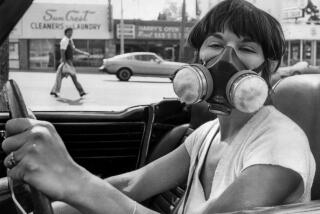Cigarette Ads: Blowing Smokeless
- Share via
For years, you’ve been looking at, but possibly not seeing, smokeless cigarettes.
They are in hand or mouth, and their ends are lit. But where there’s fire, there’s no smoke.
These magical cigarettes don’t exist in real life, but they do appear in countless advertisements. They hang from the lips of the Marlboro man. Or they help accessorize those handsome young couples who gather for Sunday brunch and Benson & Hedges.
“For people who like to smoke,” proclaims the Benson & Hedges ad sent to us by R. R. Palmisano of Rehoboth Beach, Del. “But where’s the smoke?” he asks.
If you hadn’t noticed the omission, you’re not the only one. Neither had Mary Taylor, communications director at Philip Morris USA (Marlboro, Benson & Hedges, Merit), nor Sara Ridgway, vice president for public relations at Lorillard Inc. (Kent, Newport).
“Let me get some ads,” said Taylor, somewhat surprised, when queried about the smokeless ads. “I hadn’t focused on that.”
But Palmisano suspects it is more than merely a lack of focus. He calls the smokelessness “deceptive advertising.” So does Michael Pertschuk, a longtime tobacco foe and former chairman of the Federal Trade Commission, which regulates advertising.
“It fails to disclose a material fact--that there’s smoke from smoking,” Pertschuk said. “The question is whether it rises to the level of an actionable deception. By itself, it verges on a trivial deception. But on the whole, it’s one more element of unreality.”
Guy L. Smith IV, vice president for corporate affairs of Philip Morris, scorned such allegations.
“It’s another occasion of the leading anti-smoking zealot seeing commies under the bed,” Smith said.
But are the zealots on to something? Once upon a time, visible smoke seems to have had strong sales appeal. That’s why a succession of Camel puffers painted into the three-story-high, neon-lit sign in Times Square wafted lovely “smoke” rings over millions of people for more than a quarter-century. R. J. Reynolds Tobacco Co. turned off the smoke--steam, actually--in 1965.
According to Prof. Richard W. Pollay, curator of the History of Advertising Archives at the University of British Columbia in Vancouver, the smoke began to drift out of cigarette advertising about 30 years ago.
“The motivation-research results of the 1950s indicated that smokers had ambivalent feelings,” Pollay said. They recognized “some ‘negative aspects’ of smoking, such as smells, burning clothes, some minor health hazards. . . .
“Since then, the general trend is to use art which negates these concerns with images with positive health associations, such as pure and pristine environments, and vigorous and robust behavior,” he continued.
“These are the very ‘pictures of health.’ Visible smoke is potentially perceived as a discrepant element in this imagery,” Pollay said. “It might well trigger consumer reflection on this inherent discrepancy between image and reality. . . .”
Philip Morris’ Smith dismissed Pollay’s analysis as predictable anti-smoking propaganda. “There is no conscious practice of eliminating smoke from ads,” he said. He pointed out that a number of recent ads, including some for Benson & Hedges, continue to show smoke.
The decisions to show smoke or to airbrush it out, he said, often turn on such things as whether the smoking is being done indoors or outdoors, or on the lightness or darkness of the setting.
Lorillard’s Ridgway also expressed surprise at the charge of deception. “We have no policy, nor have we ever had, to show the smoke coming from the tip of a cigarette,” she said. “We attempt to make our ads as real as possible, and in a normal setting, where action is involved in photography, you don’t see the smoke.”
In the early 1980s, Ridgway recalled, a campaign for Kent Golden Lights, emphasizing that “You Really Know You’re Smoking,” showed smoke, while many ads for Newports don’t even show cigarettes.
Smokeless Image
But a review of the recent advertising literature indicates a decided preference for the smokeless image. And it is a preference that extends even beyond consumer advertising.
In its latest annual report, for example, the Philip Morris Cos. Inc. shows packs and cartons of cigarettes nestled in arrays of carrots and mushrooms, and products of the conglomerate’s subsidiaries, such as Post Natural Raisin Bran, Ronzoni Thin Spaghetti, and Jell-O Pudding Pops.
But nowhere in the dozens of photos--including those of Hamish Maxwell, the chairman and chief executive, or the directors--is a naked cigarette to be seen.
“There was no conscious effort to not show anyone smoking,” Smith said. “Maxwell was smoking, but it was cropped out (by the corporate staff that prepared the report). He will make certain that next year he’s shown smoking. He’ll take the chairman’s privilege.”
More to Read
Inside the business of entertainment
The Wide Shot brings you news, analysis and insights on everything from streaming wars to production — and what it all means for the future.
You may occasionally receive promotional content from the Los Angeles Times.










